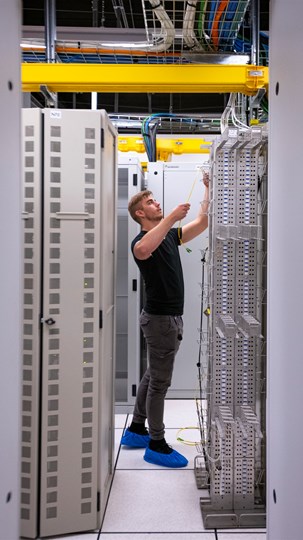Managing cables in a data center is not just a side issue. On the contrary, efficiency, a good structure and accessibility are essential. How do you ensure well-organised cable management and why is that so important? Find out in this article.
Cable management in a data center refers to labelling, organising and documenting the cabling infrastructure. Well thought-out cable management is one of the most important aspects of data center design. Here’s why:

Good management of cabling and port components in a data center will therefore significantly improve uptime, efficiency and productivity. But how exactly do you organise this cabling? And what is the best way to set up a rack? We list the five most important points:
Getting off to a good start and undergoing training are crucial for efficient cable management. Before you install the equipment, start with a clear plan and involve your team members. This will improve cable management and prevent frustration when equipment has to be moved again afterwards. An additional tip? Also include any future plans for expansion in your layout.
Sometimes you have to act fast. Can you find the right cables in your rack straightaway? Labelling cables is crucial, for both power and data cables. Clear labelling lets you know exactly where each cable goes. At LCL, we find accurate labelling very important and recommend this to all our customers. Colour codes also provide quick visual identification.
Surplus cable, or in technical terms: the 'slacks' of a cable, should be minimised as far as possible, because having metres and metres of cables in your rack creates a 'spaghetti effect', which is problematic. Surpluses or slacks should never get in the way of devices and areas where you are working. Short slacks can be conveniently hidden at the side of a cabinet, while it is best to roll up longer slacks measuring two metres or more using cable managers. Doing this keeps them separate from the rest of the work area.
Patch cables, power cables, wires, racks, switches, panels, patch panels, ... you name it. You can never have too many labels, but then you need to have a clear inventory of all numberings, markings and label information. Basically, the label should clearly state what the end of the cable is connected to. The rack name, port number and unique identification number are also important to know. In addition, make sure your physical labels match all the data and records in your digital software. This makes good real-time infrastructure management easy.
The quality of the cabling in the data center also plays an important role, of course. Bend-insensitive fibre patch cables are very flexible without sacrificing quality. LCL always opts for A brands. This ensures consistency in the installations and reliability of the circuits.
At LCL, your company enjoys optimum connectivity. Uptime is ensured by reliable cabling, rapid installation of cross-connects between customers and meet-me-rooms for cables. Our TIA-942 Rated-3 Facilities Certification, awarded by EPI, is the best proof of this.
Do you still have questions about cable management? The LCL experts are always there for you with information and advice. We give you complete peace of mind with a tailor-made solution for both new and existing infrastructure. This guarantees that the cables on your racks are protected and kept clean.
This article was created with the help of our experts:
Katrin Ceulemans – Service Manager
Noah Peeters – Customer Officer